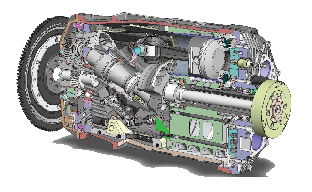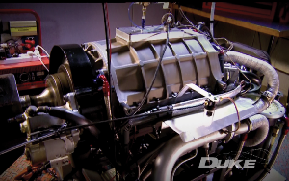The Ideal Range Extender
The Duke Engine lends itself well to Marine, Aircraft and Generator/Utility, Automotive and Hybrid electric vehicle Range Extender Applications. The Duke output shaft, being intrinsically 'geared down' to 5/6 of the piston reciprocating speed, allows the 'engine-out' torque to be higher and maximum torque to be developed at lower speeds.
The Duke Engine design consists of 3 or 5 conventional cylinders arranged axially. The cylinder group rotates counter to crankshaft at 20% of crank speed (in the Duke 5 Cylinder arrangement) causing pistons to reciprocate at 120% of crank speed. A near sinusoidal piston motion is achieved using a "Z" crank with single inclined journal and a nutating body attached to all connecting rods. 4-stroke porting and valve function is achieved using sliding seals between the low-speed rotating cylinder group and a monoplane ported surface.
Under its current design iteration the Duke Engine Range Extender concept consists of
• 5 x 250cc cylinders displacing 1500cc per 2 rotations of crankshaft.
• Near cylindrical shape 276mm x 255mm x 426mm
• Long-engine packing-crate envelope 30 litres
• Weight approx 41kg using conventional materials
• 56kW @ 4000 rpm / 70 kW@6000 rpm NVH
Major NVH features of the Extender package are
• Near sinusoidal piston motion with full balance of
primary forces
• Negligible secondary or tertiary imbalance
• 5 Cyl. Duke engine provides 3 combustion events
per output shaft rotation – as conventional 6 cyl.
• Excellent NVH potential, may allow smaller
displacement/higher speed engine to be used
• Compact combustion chamber with charge not exposed to hot exhaust valves is highly detonation resistant, enabling practicable compression ratios of 12.5:1+ on regular Gasoline
Emissions
The Duke Engine features a low speed, mono-plane sliding seal arrangement with otherwise conventional cylinders. Potential engine out emissions performance is estimated to be between Wankel and conventional engines. Due to high detonation resistance and 3 runner exhaust manifold for 5 cylinders; The Duke engine offers efficient full load operation at Lambda 1, and has a low heat loss rejection area pre-catalyst. The Duke engine offers an after-treatment friendly prospect to address emissions requirements.
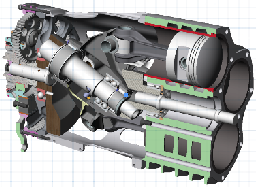
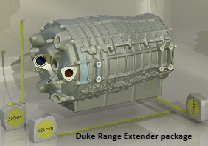
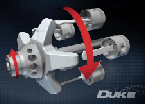


Ideal Range Extender continued –
Cost
There are many cost-saving features in the unique Duke Engines design. Just a few are:
• Low parts count on per-cylinder basis
• 5 Cylinder engine with only 3 injectors, 3 spark plugs and manifold connections
• The Duke is constructed using relatively conventional materials and manufacturing
Efficiency
The high compression ratio capable duke engine offers significant efficiency benefits.
An early, un-optimised 5 Cyl, 3.0 Litre prototype was successfully tested at Mahle UK. Results found that:
• Friction levels were comparable with conventional engines
• BSFC were comparable with modern conventional engines
• The 12.5:1 compressing ratio engine proved to be extremely detonation resistant with no detonation being identified throughout full load spark sweep testing.
Overall
The Duke engine already exhibits excellent NVH potential and good package, weight and efficiency potential. Licensing options are open and with development there is great potential for increased performance and optimization to meet specific application requirements.
